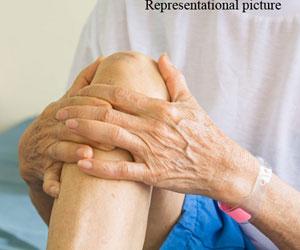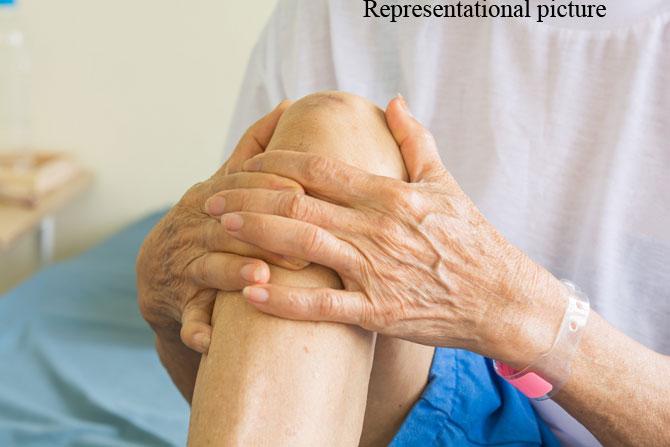Osteoporosis is a condition in which bones become fragile and brittle, leading to higher risk of breakage. This occurs when bones lose minerals such as calcium more quickly than the body can replace them

Osteoporosis is a condition in which bones become fragile and brittle, leading to higher risk of breakage. This occurs when bones lose minerals such as calcium more quickly than the body can replace them. Osteoporosis affects one in three women and one in five men over the age of 50. Referred to as a 'silent' disease, osteoporosis generally has no symptoms and is rarely diagnosed until bones break or fracture. Osteoporosis is the disease and fractures are the outcome we are trying to prevent. Dr. Miten Sheth, Orthopedic Knee Surgeon, The Knee Clinic tells us what to do home for our grandparents.
ADVERTISEMENT

Why do we get osteoporosis as we age?
Our bones are living tissue and are in a continual state of renewal. As we age, more bone is broken down (resorbed) than is replaced by new bone. Thus our bones get thinner and more fragile as we age. This is particularly true during menopause for women and in men after 60 years of age. "Primary osteoporosis" is a bone loss that can be attributed to aging or the known hormonal consequences of aging, such as decline in oestrogen and testosterone. These hormones help regulate bone renewal that occurs naturally as we age. As the level of these hormones decline from about the age of 50 in women and around 60 in men, the rate of bone breakdown is faster than the growth of new bone to replace it. Over time this leads to weaker, thinner bones. Inwomen, the risk abruptly increases from the time of menopause, coinciding with a significant drop in circulating levels of oestrogen.
'Secondary osteoporosis' occurs as a consequence of another disease (such as with chronic kidney disease), or as an adverse consequence of therapy/ medications for another disease. Thin bones of a poorer quality structure are more likely to break. The vast majority of fractures occur as a result of a fall from standing height. Vertebral or spinal fractures are an exception, frequently occurring without a fall or significant 'trigger event'. Why do we fall over when we get older? There are many reasons older adults are susceptible to falls. These include side effects of some medications, vision impairments and less ability to prevent tripping over as balance, muscle mass and strength decline with age. The risk of fracture due to poor bones increases with age, and this is further enhanced by osteoporosis. The most common sites of fracture in older adults are the hip, vertebrae or spine, wrist or the humerus (upper arm or shoulder). About 30% of older adults fall at least once a year. The less often you fall, the less likely you are to break a bone.
Preventing osteoporosis and falls
Preventing falls in older people is an important way to prevent fractures. Adults who have good balance and muscle strength are often able to “save themselves” when they trip. Exercises that improve balance and help maintain muscle mass (weight-bearing and resistance exercises) are beneficial. Preventing osteoporosis involves regular weight-bearing and resistance exercise, adequate calcium in the diet and an adequate level of vitamin D in the bloodstream. If an older adult has several risk factors for fracture their doctor may discuss the benefits of “bone active” medication. These medications slow the rate bone breaks down as we age. In general these medications halve the risk of fracture and are much more effective than lifestyle measures alone.
You can make your home safe from falls with just a few basic changes. This doesn’t have to involve a complete house remodel. Simple measures to prevent falls at home;
>> Clean up clutter. The easiest method for preventing falls is to keep your home neat and tidy. Remove all clutter, such as stacks of old newspapers and magazines, especially from hallways and staircases.
>> Repair or remove tripping hazards. Sometimes home fixtures can contribute to falls, which can then lead to back pain and other injuries. Examine every room looking for items such as loose carpet, slippery throw rugs and broken tiles or flooring. Repair, remove, or replace such items for more effective fall prevention.
>> Install grab bars and handrails. These safety devices are crucial for getting on and off the toilet, and stepping in and out of the shower without injuring yourself.
>> Avoid wearing loose clothing. You want to feel comfortable at home, but baggy clothes can sometimes make you more likely to fall. Opt for better-fitting and properly hemmed clothing that doesn’t bunch up or drag on the ground.
>> Light it right. Inadequate lighting is another major hazard. To create a home that’s more suitable for the elderly, install brighter light bulbs where needed, particularly in hallways. Add night-lights in bedrooms and bathrooms for better guidance at night.
>> Wear shoes if you wear socks. Socks may be comfortable, but they present a slipping risk.
>> Make the flooring nonslip. Nonslip mats are a must, especially in the bathroom.
>> Live on one level. Even with precautions like guardrails, stairs can present a significant falling hazard.
>> Move more carefully. Many people fall at home by moving too quickly from a sitting to a standing position and vice versa. Preventing falls like this is as easy as taking your time. "All you have to do is take a short pause after going from lying down to sitting and from sitting to standing."
Catch up on all the latest Mumbai, National and International news here
Download the new mid-day Android and iOS apps to get updates on all the latest and trending stories on the go
 Subscribe today by clicking the link and stay updated with the latest news!" Click here!
Subscribe today by clicking the link and stay updated with the latest news!" Click here!






